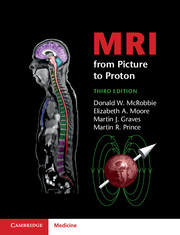Book contents
- MRI from Picture to ProtonThird Edition
- MRI from Picture to Proton
- Copyright page
- Dedication
- Contents
- Glossary
- Chapter 1 MR: What’s the Attraction?
- Part I The Basic Stuff
- Part II The Specialist Stuff
- Chapter 12 Acronyms Anonymous I: Spin Echo
- Chapter 13 Acronyms Anonymous II: Gradient Echo
- Chapter 14 The Parallel Universe: Parallel Imaging and Novel Acquisition Techniques
- Chapter 15 Go with the Flow: MR Angiography
- Chapter 16 A Heart to Heart Discussion: Cardiac MRI
- Chapter 17 It’s Not Just Squiggles: In Vivo Spectroscopy
- Chapter 18 To BOLDly Go: fMRI, Perfusion and Diffusion
- Chapter 19 Making it Count: Quantitative MRI
- Chapter 20 But is it Safe? Bio-effects
- Chapter 21 Where Are We Going Now?
- Appendix: maths revision
- Index
- References
Chapter 18 - To BOLDly Go: fMRI, Perfusion and Diffusion
from Part II - The Specialist Stuff
Published online by Cambridge University Press: 28 April 2017
- MRI from Picture to ProtonThird Edition
- MRI from Picture to Proton
- Copyright page
- Dedication
- Contents
- Glossary
- Chapter 1 MR: What’s the Attraction?
- Part I The Basic Stuff
- Part II The Specialist Stuff
- Chapter 12 Acronyms Anonymous I: Spin Echo
- Chapter 13 Acronyms Anonymous II: Gradient Echo
- Chapter 14 The Parallel Universe: Parallel Imaging and Novel Acquisition Techniques
- Chapter 15 Go with the Flow: MR Angiography
- Chapter 16 A Heart to Heart Discussion: Cardiac MRI
- Chapter 17 It’s Not Just Squiggles: In Vivo Spectroscopy
- Chapter 18 To BOLDly Go: fMRI, Perfusion and Diffusion
- Chapter 19 Making it Count: Quantitative MRI
- Chapter 20 But is it Safe? Bio-effects
- Chapter 21 Where Are We Going Now?
- Appendix: maths revision
- Index
- References
- Type
- Chapter
- Information
- MRI from Picture to Proton , pp. 303 - 325Publisher: Cambridge University PressPrint publication year: 2017



